#Pet Market Revenue
Text
Exploring New Directions in the Pet Care Sector

Introduction
The Pet Care Market is in a constant state of flux, with ongoing trends and innovations reshaping its landscape. In this article, we delve into some of the emerging trends in the pet care market and their impact on industry participants.
Tailored Nutrition
A notable trend in the Pet Care Market is the move towards personalized nutrition. Pet owners are increasingly seeking tailored diet plans and nutritional solutions to meet the specific needs of their pets. Responding to this demand, companies are offering customized pet food formulas and supplements designed to address various health concerns and dietary preferences.
E-commerce Expansion
The surge in e-commerce has transformed the way pet care products are purchased and sold. Online platforms provide convenience and accessibility, enabling pet owners to explore a wide array of products and make purchases from the comfort of their homes. This shift has led to the proliferation of online pet stores and the adoption of subscription-based models for pet food and supplies.
Emphasis on Sustainability
Sustainability has emerged as a significant focus area for both pet care companies and consumers. With increasing worries about environmental conservation and climate change, pet owners are seeking eco-friendly and sustainable pet care products. In response, companies are integrating recycled materials, minimizing packaging waste, and embracing sustainable manufacturing practices.
Technology-Driven Solutions
Technological advancements are fueling innovation in the pet care market. From wearable devices and smart collars to pet monitoring apps and telemedicine services, technology is revolutionizing how pet owners interact with their pets and manage their health and well-being. These tech-driven solutions offer convenience, efficiency, and peace of mind to pet owners, driving their adoption and integration into daily pet care routines.
Growing CBD Market
Another noteworthy trend in the pet care market is the increasing popularity of CBD products for pets. CBD, or cannabidiol, is a non-psychoactive compound derived from the cannabis plant, believed to offer various health benefits for pets, including pain relief, anxiety reduction, and improved mobility. As more research is conducted on the potential benefits of CBD for pets, the market for CBD pet products is expected to expand significantly.
Conclusion
The Pet Care Industry is undergoing rapid evolution, spurred by shifting consumer preferences, technological breakthroughs, and heightened awareness of pet health and wellness. By staying attuned to emerging trends and embracing innovation, companies can position themselves for success in this dynamic and competitive industry.
#Pet Market Analysis#Pet Market Size#Cat food manufacturers#Online dog food sales#Online pet food companies#Top pet companies#Pet Industry#Pet Industry research reports#Pet market research reports#Pet Market Demand#Pet Market Forecast#Pet Market Growth#Pet Market Outlook#Pet Market Revenue#Pet Market Trends#Pet Market Report#Pet Market Challenges#Pet Market Opportunities#Pet food and nutrition Industry research report#Pet food and nutrition Market Analysis#Pet food and nutrition Market Demand#Pet food and nutrition Market Forecast#Pet food and nutrition Market Growth#Pet food and nutrition Market Outlook#Pet food and nutrition Market Revenue#Pet food and nutrition Market Size#Pet food and nutrition Market Trends
0 notes
Text
Navigating the Pet Market Exploring the Market Trends, Growth, and Outlook
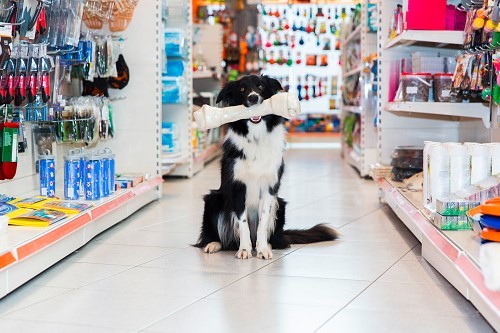
In the Pet Care industry, it is crucial to understand the Pet Market for pet owners, businesses, and enthusiasts alike. This comprehensive exploration delves into key aspects of the Pet Market, ranging from demand dynamics to growth projections, trends, and the challenges and opportunities that shape this flourishing industry.
Exploring Pet Market Research Reports: A Wealth of Insights
The Pet Market Research Reports serve as beacons of information, offering a comprehensive understanding of the industry's landscape. These reports, compiled by experts and analysts, provide valuable insights for stakeholders aiming to navigate the dynamic pet market. Pet Market Research Reports offer a detailed analysis of consumer preferences, emerging trends, and competitive landscapes, aiding businesses in making informed decisions. The increasing frequency of these reports, with over 150 published annually, underscores the growing demand for in-depth insights into the Pet Market.
Unraveling Pet Market Demand: Understanding Consumer Preferences
The heartbeat of the Pet Market lies in understanding what consumers seek for their furry companions. Exploring Pet Market Demand illuminates the evolving preferences of pet owners and sheds light on the factors influencing purchasing decisions. Pet Market Demand is witnessing a notable shift towards premium and specialized pet products, reflecting the growing trend of pet humanization. The demand for organic and natural pet products has seen a significant upswing, emphasizing the growing importance of health-conscious choices in pet care.
Forecasting Pet Market Trends: Peering into the Future
Anticipating trends is essential in a market as dynamic as pet care. Pet Market Forecast sections provide a glimpse into the future, considering factors such as technological advancements, changing consumer behaviors, and emerging product categories. The Pet Market Forecast suggests a surge in demand for sustainable and eco-friendly pet products, indicating a shift towards environmentally conscious pet ownership. Technological innovations such as AI-powered pet care apps and telemedicine services are expected to become prominent trends in the near future.
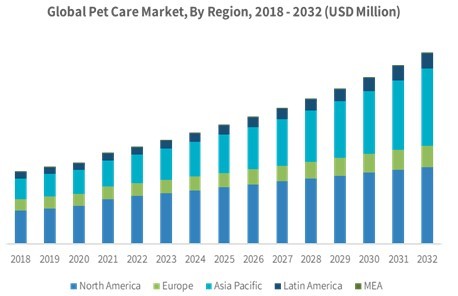
Pet Market Growth: Nurturing a Flourishing Industry
The continuous growth of the Pet Market is a testament to the unwavering love and care bestowed upon pets. Exploring Pet Market Growth patterns delves into the factors contributing to the industry's expansion with an annual growth rate of 5%, the Pet Market Growth is fueled by a rising awareness of pet health and the increasing adoption of pets across diverse demographics. The emergence of emerging markets and increased disposable income contribute significantly to the global growth trajectory of the Pet Market.
Outlook on Pet Market Opportunities: Navigating Possibilities
Amidst challenges, opportunities abound in the Pet Market. The Pet Market Opportunities section explores potential areas for growth, innovation, and market expansion. Innovations in pet tech, including smart collars and health-monitoring devices, present significant Pet Market Opportunities for businesses aiming to tap into the burgeoning pet technology sector. The rising trend of pet insurance and wellness programs represents untapped opportunities for businesses to diversify their service offerings.
Harvesting Pet Market Revenue: Understanding Financial Dynamics
For businesses, comprehending the financial aspects of the Pet Market is crucial. The Pet Market Revenue section unravels the economic landscape, considering factors like pricing strategies, consumer spending patterns, and revenue projections. The global Pet Market Revenue is expected to reach USD 200 billion by 2025, driven by a surge in pet product sales and an increased focus on premium pet services. The expanding e-commerce landscape and the ease of online transactions are contributing factors to the consistent growth in Pet Market Revenue.
Trends Painting Pet Market: Unveiling Consumer Preferences
The pet market is not immune to trends that shape consumer behaviors. Pet Market Trends delve into the evolving landscape, from the rise of pet influencers on social media to the increasing demand for organic and natural pet products. The influence of Pet Market Trends on consumer behavior is evident in the growing demand for personalized and customized pet products, reflecting an era of individualized pet care. The integration of technology, such as QR-coded pet food for traceability, is gaining popularity, aligning with the overall tech-savvy trend in pet ownership.
Challenges in Pet Market: Navigating Obstacles
Every industry has its hurdles, and the Pet Market is no exception. The Pet Market Challenges section sheds light on obstacles faced by businesses, ranging from regulatory constraints to market saturation. Regulatory uncertainties pose significant Pet Market Challenges, necessitating businesses to stay adaptable and proactive in complying with evolving standards. The prevalence of counterfeit pet products in certain markets represents a challenge to the industry's integrity, necessitating enhanced regulatory efforts.
Conclusion: Embracing the Pet Market Dynamics
The Pet Market is a vibrant and ever-evolving landscape shaped by the love and care bestowed upon our beloved pets. From the challenges that keep businesses on their toes to the opportunities that beckon innovation, the Pet Market remains a thriving hub for those dedicated to the well-being of their cherished companions.
#Pet Market Analysis#Pet Market Size#Online Dog Food Sales#Online Pet Food Companies#Top Pet Companies#Pet Industry#Pet Industry Research Reports#Pet Market Research Reports#Pet Market Demand#Pet Market Forecast#Pet Market Growth#Pet Market Outlook#Pet Market Revenue#Pet Market Trends#Pet Market Report#Pet Market Challenges#Pet Market Opportunities#Pet Food and Nutrition Industry Research Report#Pet Food and Nutrition Market Analysis#Pet Food and Nutrition Market Demand#Pet Food and Nutrition Market Forecast#Pet Food and Nutrition Market Growth#Pet Food and Nutrition Market Outlook#Pet Food and Nutrition Market Revenue#Pet Food and Nutrition Market Size#Pet Food and Nutrition Market Trends
1 note
·
View note
Text
Pet Grooming and Accessories Market Share, Trends, Revenue, Growth Opportunities, Challenges, and Competitive Analysis 2033: SPER Market Research
The industry that produces and offers a broad range of products and services aimed at enhancing the comfort, safety, and general well-being of pets is known as the pet accessories market. These products include beds, toys, collars, leashes, harnesses, grooming tools, and other things. Organic food and supplements for pets' health are also sold at the market. The market for pet accessories is a rapidly growing industry that provides a variety of products and services meant to improve the lives of animals. The market has everything from luxuries like jewelry and clothing from leading brands to basics like food and hygiene.
According to SPER market research, ‘Pet Accessories Market Size- By Product, By Distribution Channel, By End User- Regional Outlook, Competitive Strategies and Segment Forecast to 2033’ state that the Global PET Accessories Market is predicted to reach USD 18.09 billion by 2033 with a CAGR of 6.34%.
The growing number of people owning pets is driving up demand for pet accessories. With more individuals adopting dogs, there is a growing need for pet accessories such as beds, toys, collars, leashes, harnesses, and grooming items. Pet owners are also willing to shell out extra cash for accessories that will make their animals feel more secure and comfortable. Furthermore, as the number of pet owners expands, more individuals are becoming concerned about the overall welfare, diet, and health of their animals. The demand for products related to pet wellbeing, such as organic food and vitamins, is rising as a result. The need for a range of products and services targeted at improving pets' life is increased by the rise in pet ownership, which is primarily responsible for the expansion of the pet accessories industry.
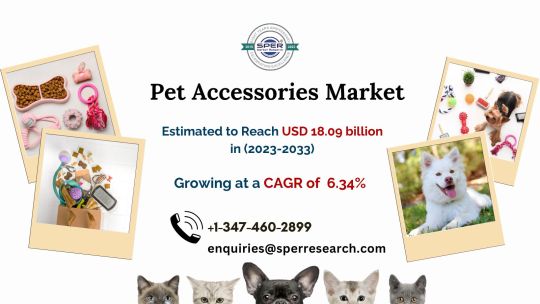
Pet owners only purchase accessories when absolutely essential. Consequently, sporadic purchases and a brief replacement cycle of these accessories hinder the market's growth. Pet accessories are either purchased for brand-new pets or when worn-out ones need to be replaced because of their longer average lifespan. Since they are meant to be used for an extended period of time, they do not require regular replacement. The majority of these products are high-quality and long-lasting. Over time, pet owners only need to pay a little amount in maintenance fees for this. Consequently, there will be a decrease in the need for regular purchases, which poses a major obstacle to the expansion of the pet accessories industry.
Request For Free Sample Report @ https://www.sperresearch.com/report-store/pet-accessories-market.aspx?sample=1
The COVID-19 pandemic has had an unprecedented and catastrophic worldwide impact. The demand for pet accessories has exceeded expectations in every area when compared to pre-pandemic levels. The epidemic has also resulted in a rise in online pet accessory sales. Because so many physical pet companies have closed or are working at reduced capacity, a growing number of pet owners are increasingly purchasing supplies for their pets online. The pandemic has also raised demand for organic food, vitamins for pets, and other products related to pet wellbeing.
Pet Accessories Market Key Players:
Geographically, The region with the most predicted influence on global market growth is predicted to be North America. The trend of humanizing pets is driving the market share of pet accessories in North America. Key players are Ancol Pet Product, Blueberry Pet, Designer Pet Products, Dobbies Garden Centres Ltd, Ferplast Spa, Go Pet Club, Hagen Group, InterIKEA Holdings BV, KandH Pet Products, Laroy Group, Petcraft, Pets Choice Ltd, Platinum Pets, Unicharm Corp
Global Pet Accessories Market Segmentation:
By Product: Based on the Product, Global Pet Accessories Market is segmented as; Carriers, Collar and Harness, Grooming Products, Housing and Bedding, Pet Toys, Others.
By Distribution Channel: Based on the Distribution Channel, Global Pet Accessories Market is segmented as; Offline, Online.
By End User: Based on the End User, Global Pet Accessories Market is segmented as; Dogs, Cats, Others
By Region: This report also provide the data for key regional segments of Asia-Pacific, Europe, Middle East and Africa, North America, Latin America
This study also encompasses various drivers and restraining factors of this market for the forecast period. Various growth opportunities are also discussed in the report.
For More Information, refer to below link:-
Pet Grooming and Accessories Market Outlook
Related Reports:
Electric Lunch Box Market Size- By Type, By Technology, By Material Use, By Application, By End User- Regional Outlook, Competitive Strategies and Segment Forecast to 2033
Bean Bag Chairs Market Size- By Product type, By Distribution Channels, By End User- Regional Outlook, Competitive Strategies and Segment Forecast to 2033
Follow Us –
LinkedIn | Instagram | Facebook | Twitter
Contact Us:
Sara Lopes, Business Consultant – U.S.A.
SPER Market Research
+1-347-460-2899
#Pet Grooming Products Market#Pet Grooming and Accessories Market#PET Accessories Market#PET Accessories Market Analysis#PET Accessories Market Challenges#PET Accessories Market Competition#PET Accessories Market Demand#PET Accessories Market Forecast#PET Accessories Market Future outlook#PET Accessories Market Growth#PET Accessories Market Opportunity#PET Accessories Market Overview#PET Accessories Market Research Report#PET Accessories Market Revenue#PET Accessories Market segmentation#PET Accessories Market Share#PET Accessories Market Size#PET Accessories Market Top Industry Players#PET Accessories Market Trends#USA PET Accessories Market#Canada PET Accessories Market#Europe PET Accessories Market#Global PET Accessories Market
0 notes
Text
CBD Pet Market Segmented On The Basis Of Animal Type, Indication, Distribution Channel, Region And Forecast To 2030: Grand View Research Inc.
San Francisco, 17 March 2023: The Report CBD Pet Market Size, Share & Trends Analysis Report By Animal Type (Dogs, Cats), By Indication (Joint Pain, Anxiety/Stress, General Health/Wellness), By Distribution Channel, By Region, And Segment Forecasts, 2023 – 2030
The global CBD pet market size is expected to reach USD 1.71 billion by 2030, according to a new report by Grand View Research, Inc. The…
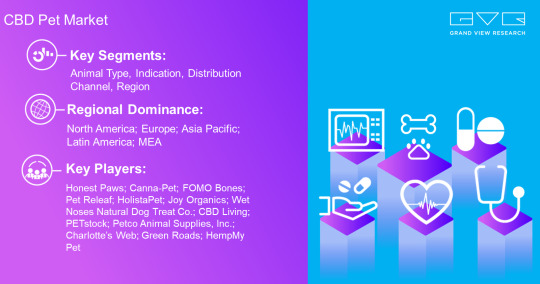
View On WordPress
#CBD Pet Industry#CBD Pet Market#CBD Pet Market 2023#CBD Pet Market 2030#CBD Pet Market Revenue#CBD Pet Market Share#CBD Pet Market Size
0 notes
Text
Germany Pet Insurance Market Growth Attributable To Increasing Prevalence Of Acute And Chronic Pet Health Diseases
The Germany pet insurance market size is anticipated to reach USD 2.65 billion by 2030, according to a new report by Grand View Research, Inc. The regional market is expected to expand at a CAGR of 14.6% from 2022 to 2030. The market growth is attributable to the increasing prevalence of acute and chronic pet health diseases, the rising humanization of pets, and supportive government regulations. For example, liability insurance is compulsory for certain dangerous dog breeds in the states of Saarland, Bremen, Hessen, Nordrhein-Westfalen, and Baden-Wurttemberg.
The COVID-19 outbreak catalyzed the market with a surge in pet adoption and pet health concerns. Wertgarantie Group, the parent company of Agila, reported an exponential rise in the purchase of dogs and cats in Germany in 2020, amid the pandemic. This positively affected the company’s pet health insurance business with about 340,000 new contracts. However, this number contrasted the 475,000 veterinary bills processed during the period for the benefit of customers.
Gain deeper insights on the market and receive your free copy with TOC now @: Germany Pet Insurance Market Report
As pet owners are becoming increasingly concerned about their pet’s health and wellbeing, the demand for pet insurance is expected to increase over time, due to high costs of treatment and surgery, awareness about pet health & diseases, and pet humanization. In addition, changing customer requirements, digitalization in the banking & insurance sectors, and the adoption of veterinary telehealth is estimated to fuel the market growth.
Intuitive pet insurance plans, quick checkouts, and offering online management of pet plans are some of the common features offered by fully digital insurance companies or Insurtech companies in the country. These trends are expected to continue during the forecast period. As per a 2018 survey by YouGov, the majority of Germans (around 52%) indicated a preference for managing their insurance contracts via online banking. The COVID-19 pandemic has further increased this preference.
Market players are involved in providing affordable and tailored insurance products to suit the needs and budgets of pet parents. These include monthly or annual plans, plans based on coverage type, and sold through various sales channels. Barmenia Insurance, for instance, offers horse surgery insurance that provides coverage from colic protection to premium surgery costs.
The company’s dog and cat health insurance plans come in 4 variants, wherein all plans cover operations, including partial anesthesia or local anesthesia with no annual maximum. Service additions to enhance product value is another unique selling point observed in the German pet insurance market. DFV Deutsche Familienversicherung AG, for example, partnered with FirstVet to offer veterinary telemedicine services to its animal health policyholders, thus expanding its offerings.
#Germany Pet Insurance Market Size & Share#Germany Pet Insurance Market Latest Trends#Germany Pet Insurance Market Growth Forecast#COVID-19 Impacts On Germany Pet Insurance Market#Germany Pet Insurance Market Revenue Value
0 notes
Text
the c in NRC stands for cat
synopsis: in which heartslabyul deals with a cat loving no-magic having ramshackle prefect. (headcanons)
gn!yuu

RIDDLE ROSEHEARTS
when he saw you clinging to the raccoon-cat-thing at the entrance ceremony, he did not know how to react.
normal people would panic. normal people would avoid a fire-breathing monster-cat-whatever that was spewing absolute nonsense.
apparently not you, though. although, one could say you already aren’t normal, considering the lack of magic. it wasn’t just not that much potential, you were basically in the negatives.
anyways, cats.
he got a peek under your ceremonial robes, and you were wearing..
a pajama shirt with a cat print on it. it looked horrendous.
riddle himself grew up with.. well, a cat. beastperson. so he probably would only have a surface level of appreciation for their greatness.
6/10 for cat lovers, i guess. he wouldn’t really mind, but he’d think it a tad strange. lower points because it took him a while to finally start letting grim into areas of festivity.

TREY CLOVER
this guy has siblings. like, siblings siblings. he’s used to being around people with strange interests (his brother tried to feed him a live insect once. not fun).
so, i’m sure he appreciates that your interests are on the much safer side of the wide, wide spectrum.
except when the two of you hang out while he’s baking and suddenly ace and deuce are complaining about cat hair in their tarts.
please do not bring your cats in the kitchen, thank you very much.
he’d feed your cat(s)! very sweet guy.
8/10 for cat lovers! good ascend from riddles, except two points taken from him because one, the Cat™ isn’t allowed in the kitchen and two, he just seems like a dog person to me.

CATER DIAMOND
please do not turn the great grim into a marketable plushie.
cater.
just kidding, he wouldn’t do that.
or would he?
i think he’d be a good cat co-parent! just like trey, i think he’d feed your cat when you can’t, he’d catsit while you’re in class.. etc, etc.
mostly because the posts he makes of your cat blow up, but also because he likes your cat!
the level fluctuates depending if this cat is grim or not. please do not ask me why.
8/10 for cat lovers! not bad, not bad at all! except, now there’s merch of grim- and while he’s proud of himself (this is only to be expected for the great grim! according to him), you just wish you got some of the revenue.

ACE TRAPPOLA
no.
just, no.
i think he’d look at a cat litter and go, “what’s that?”. maybe he’d even try to sniff it.
gives off grew up with a dog vibes, i don’t know why.
he goes like “EUGH” when he finds cat hair in the food you made for him.
you felt kinda bad, but he ate it anyways while complaining. you were pretty conflicted.
he’d be.. i don’t know. unremarkable. not that good, though.
5/10 for the cat lovers. no comment. this gremlin, i swear.

DEUCE SPADE
he LITERALLY isn’t any better than ace.
maybe he used to feed some of the stray cats on the way home from school when he was in elementary, but that’s probably the extent of his experience.
will also complain about cat hair. politely.
“uhm.. i think grims hair is in my soup?” kind of polite. except he’s grimacing and staring at grim like the cat just insulted his mother and all his ancestors.
he will also sniff your cat litter. and grim will laugh in the heartslabyul first year duo’s faces.
thanks, grim.
5/10 for the cat lovers.. again. he’s really just the same. he’d probably be nicer than ace, but the latter just has more experience with pets. probably. hopefully.


special guest, IDIA SHROUD!
do i even need to say anything?
you two have matching cat print pajamas. ortho would cry tears of joy if he could.
you bring your cats to ignihyde and you all hang out. <3
you, idia, and your 23 cats. it really is the life.
he paid you in genesis crystals for permission to pat one of your cats on the head.
you two have a cat lovers gc where you just send cat pictures and talk about your cats, very fun.
10/10 for cat lovers! first ever 10/10, and it’s from idia shroud? riddle is seething. great cat parent! though, he’s a bit attached. it’s okay, though, he buys your cats toys.
#“he is half of my soul.” ; my writing#twisted wonderland#twisted wonderland x reader#twst#twst x reader#riddle rosehearts#riddle rosehearts x reader#trey clover#trey clover x reader#cater diamond#cater diamond x reader#ace trappola#ace trappola x reader#deuce spade#deuce spade x reader#twst headcanons#twst wonderland#heartslabyul#heartslabyul x reader#idia shroud#idia shroud x reader#ignihyde
397 notes
·
View notes
Text
The long, bloody lineage of private equity's looting

Tomorrow (June 3) at 1:30PM, I’m in Edinburgh for the Cymera Festival on a panel with Nina Allen and Ian McDonald.
Monday (June 5) at 7:15PM, I’m in London at the British Library with my novel Red Team Blues, hosted by Baroness Martha Lane Fox.

Fans of the Sopranos will remember the “bust out” as a mob tactic in which a business is taken over, loaded up with debt, and driven into the ground, wrecking the lives of the business’s workers, customers and suppliers. When the mafia does this, we call it a bust out; when Wall Street does it, we call it “private equity.”
It used to be that we rarely heard about private equity, but then, as national chains and iconic companies started to vanish, this mysterious financial arrangement popped up with increasing frequency. When a finance bro’s presentation on why Olive Garden needed to be re-orged when viral, there was a lot off snickering about the decline of a tacky business whose value prop was unlimited carbs. But the bro was working for Starboard Value, a hedge fund that specialized in buhying out and killing off companies, pocketing billions while destroying profitable businesses.
https://www.salon.com/2014/09/17/the_real_olive_garden_scandal_why_greedy_hedge_funders_suddenly_care_so_much_about_breadsticks/
Starboard Value’s game was straightforward: buy a business, load it with debt, sell off its physical plant — the buildings it did business out of — pay itself, and then have the business lease back the buildings, bleeding out money until it collapsed. They pulled it with Red Lobster,and the point of the viral Olive Garden dis track was to soften up the company for its own bust out.
The bust out tactic wasn’t limited to mocking middlebrow family restaurants. For years, the crooks who ran these ops did a brisk trade in blaming the internet. Why did Sears tank? Everyone knows that the 19th century business was an antique, incapable of mounting a challenge in the age of e-commerce. That was a great smokescreen for an old-fashioned bust out that saw corporate looters make off with hundreds of millions, leaving behind empty storefronts and emptier pension accounts for the workers who built the wealth the looters stole:
https://prospect.org/economy/vulture-capitalism-killed-sears/
Same goes for Toys R Us: it wasn’t Amazon that killed the iconic toy retailer — it was the PE bosses who extracted $200m from the chain, then walked away, hands in pockets and whistling, while the businesses collapsed and the workers got zero severance:
https://www.washingtonpost.com/news/business/wp/2018/06/01/how-can-they-walk-away-with-millions-and-leave-workers-with-zero-toys-r-us-workers-say-they-deserve-severance/
It’s a good racket — for the racketeers. Private equity has grown from a finance sideshow to Wall Street’s apex predator, and it’s devouring the real economy through a string of audactious bust outs, each more consequential and depraved than the last.
As PE shows that it can turn profitable businesses gigantic windfalls, sticking the rest of us with the job of sorting out the smoking craters they leave behind, more and more investors are piling in. Today, the PE sector loves a rollup, which is when they buy several related businesses and merge them into one firm. The nominal business-case for a rollup is that the new, bigger firm is more “efficient.” In reality, a rollup’s strength is in eliminating competition. When all the pet groomers, or funeral homes, or urgent care clinics for ten miles share the same owner, they can raise prices, lower wages, and fuck over suppliers.
They can also borrow. A quirk of the credit markets is that a standalone small business is valued at about 3–5x its annual revenues. But if that business is part of a large firm, it is valued at 10–20x annual turnover. That means that when a private equity company rolls up a comedy club, ad agency or water bottler (all businesses presently experiencing PE rollup), with $1m in annual revenues, it shows up on the PE company’s balance sheet as an asset worth $10–20m. That’s $10–20m worth of collateral the PE fund can stake for loans that let it buy and roll up more small businesses.
2.9 million Boomer-owned businesses, employing 32m people, are expected to sell in the next couple years as their owners retire. Most of these businesses will sell to PE firms, who can afford to pay more for them as a prelude to a bust out than anyone intending to operate them as a productive business could ever pay:
https://pluralistic.net/2022/12/16/schumpeterian-terrorism/#deliberately-broken
PE’s most ghastly impact is felt in the health care sector. Whole towns’ worth of emergency rooms, family practices, labs and other health firms have been scooped up by PE, which has spent more than $1t since 2012 on health acquisitions:
https://pluralistic.net/2022/11/17/the-doctor-will-fleece-you-now/#pe-in-full-effect
Once a health care company is owned by PE, it is significantly more likely to commit medicare fraud. It also cuts wages and staffing for doctors and nurses. PE-owned facilities do more unnecessary and often dangerous procedures. Appointments get shorter. The companies get embroiled in kickback scandals. PE-backed dentists hack away at children’s mouths, filling them full of root-canals.
https://pluralistic.net/2022/11/17/the-doctor-will-fleece-you-now/#pe-in-full-effect
The Healthcare Private Equity Association boasts that its members are poised to spend more than $3t to create “the future of healthcare.”
https://hcpea.org/#!event-list
As bad as PE is for healthcare, it’s worse for long-term care. PE-owned nursing homes are charnel houses, and there’s a particularly nasty PE scam where elderly patients are tricked into signing up for palliative care, which is never delivered (and isn’t needed, because the patients aren’t dying!). These fake “hospices” get huge payouts from medicare — and the patient is made permanently ineligible for future medicare, because they are recorded being in their final decline:
https://pluralistic.net/2023/04/26/death-panels/#what-the-heck-is-going-on-with-CMS
Every part of the health care sector is being busted out by PE. Another ugly PE trick, the “club deal,” is devouring the medical supply business. Club deals were huge in the 2000s, destroying rent-controlled housing, energy companies, Mervyn’s department stores, Harrah’s, and Old Country Joe. Now it’s doing the same to medical supplies:
https://pluralistic.net/2021/05/14/billionaire-class-solidarity/#club-deals
Private equity is behind the mass rollup of single-family homes across America. Wall Street landlords are the worst landlords in America, who load up your rent with junk fees, leave your home in a state of dangerous disrepair, and evict you at the drop of a hat:
https://pluralistic.net/2021/08/16/die-miete-ist-zu-hoch/#assets-v-human-rights
As these houses decay through neglect, private equity makes a bundle from tenants and even more borrowing against the houses. In a few short years, much of America’s desperately undersupplied housing stock will be beyond repair. It’s a bust out.
You know all those exploding trains filled with dangerous chemicals that poison entire towns? Private equity bust outs:
https://pluralistic.net/2022/02/04/up-your-nose/#rail-barons
Where did PE come from? How can these people look themselves in the mirror? Why do we let them get away with it? How do we stop them?
Today in The American Prospect, Maureen Tkacik reviews two new books that try to answer all four of these questions, but really only manage to answer the first three:
https://prospect.org/culture/books/2023-06-02-days-of-plunder-morgenson-rosner-ballou-review/
The first of these books is These Are the Plunderers: How Private Equity Runs — and Wrecks — America by Gretchen Morgenson and Joshua Rosner:
https://www.simonandschuster.com/books/These-Are-the-Plunderers/Gretchen-Morgenson/9781982191283
The second is Plunder: Private Equity’s Plan to Pillage America, by Brendan Ballou:
https://www.hachettebookgroup.com/titles/brendan-ballou/plunder/9781541702103/
Both books describe the bust out from the inside. For example, PetSmart — looted for $30 billion by RaymondSvider and his PE fund BC Partners — is a slaughterhouse for animals. The company systematically neglects animals — failing to pay workers to come in and feed them, say, or refusing to provide backup power to run during power outages, letting animals freeze or roast to death. Though PetSmart has its own vet clinics, the company doesn’t want to pay its vets to nurse the animals it damages, so it denies them care. But the company is also too cheap to euthanize those animals, so it lets them starve to death. PetSmart is also too cheap to cremate the animals, so its traumatized staff are ordered to smuggle the dead, rotting animals into random dumpsters.
All this happened while PetSmart’s sales increased by 60%, matched by growth in the company’s gross margins. All that money went to the bust out.
https://www.forbes.com/sites/antoinegara/2021/09/27/the-30-billion-kitty-meet-the-investor-who-made-a-fortune-on-pet-food/
Tkacik says these books show that we’re finally getting wise to PE. Back in the Clinton years, the PE critique painted the perps as sharp operators who reduced quality and jacked up prices. Today, books like these paint these “investors” as the monsters they are — crooks whose bust ups are crimes, not clever finance hacks.
Take the Carlyle Group, which pioneered nursing home rollups. As Carlyle slashed wages, its workers suffered — but its elderly patients suffered more. Thousands of Carlyle “customers” died of “dehydration, gangrenous bedsores, and preventable falls” in the pre-covid years.
https://www.washingtonpost.com/business/economy/opioid-overdoses-bedsores-and-broken-bones-what-happened-when-a-private-equity-firm-sought-profits-in-caring-for-societys-most-vulnerable/2018/11/25/09089a4a-ed14-11e8-baac-2a674e91502b_story.html
KKR, another PE monster, bought a second-hand chain of homes for mentally disabled adults from another PE company, then squeezed it for the last drops of blood left in the corpse. KKR cut wages to $8/hour and increased shifts to 36 hours, then threatened to have workers who went home early arrested and charged with “patient abandonment.” Many of these homes were often left with no staff at all, with patients left to starve and stew in their own waste.
PE loves to pick on people who can’t fight back: kids, sick people, disabled people, old people. No surprise, then, that PE loves prisons — the ultimate captive audience. HIG Capital is a $55b fund that owns TKC Holdings, who got the contract to feed the prisoners at 400 institutions. They got the contract after the prisons fired Aramark, owned by PE giant Warburg Pincus, whose food was so inedible that it provoked riots. TKC got a million bucks extra to take over the food at Michigan’s Kinross Correctional Facility, then, incredibly, made the food worse. A chef who refused to serve 100 bags of rotten potatoes (“the most disgusting thing I’ve seen in my life”) was fired:
https://www.wzzm13.com/article/news/local/michigan/prison-food-worker-i-was-fired-for-refusing-to-serve-rotten-potatoes/69-467297770
TKC doesn’t just operate prison kitchens — it operates prison commissaries, where it gouges prisoners on junk food to replace the inedible slop it serves in the cafeteria. The prisoners buy this food with money they make working in the prison workshops, for $0.10–0.25/hour. Those workshops are also run by TKC.
Tkacic traces private equity back to the “corporate raiders” of the 1950s and 1960s, who “stealthily borrowed money to buy up enough shares in a small or midsized company to control its biggest bloc of votes, then force a stock swap and install himself as CEO.”
The most famous of these raiders was Eli Black, who took over United Fruit with this gambit — a company that had a long association with the CIA, who had obligingly toppled democratically elected governments and installed dictators friendly to United’s interests (this is where the term “banana republic” comes from).
Eli Black’s son is Leon Black, a notorious PE predator. Leon Black got his start working for the junk-bonds kingpin Michael Milken, optimizing Milken’s operation, which was the most terrifying bust out machine of its day, buying, debt-loading and wrecking a string of beloved American businesses. Milken bought 2,000 companies and put 200 of them through bankruptcy, leaving the survivors in a brittle, weakened state.
It got so bad that the Business Roundtable complained about the practice to Congress, calling Milken, Black, et al, “a small group is systematically extracting the equity from corporations and replacing it with debt, and incidentally accumulating major wealth.”
Black stabbed Milken in the back and tanked his business, then set out on his own. Among the businesses he destroyed was Samsonite, “a bankrupt-but-healthy company he subjected to 12 humiliating years of repeated fee extractions, debt-funded dividend payments, brutal plant closings, and hideous schemes to induce employees to buy its worthless stock.”
The money to buy Samsonite — and many other businesses — came through a shadowy deal between Black and John Garamendi, then a California insurance commissioner, now a California congressman. Garamendi helped Black buy a $6b portfolio of junk bonds from an insurance company in a wildly shady deal. Garamendi wrote down the bonds by $3.9b, stealing money “from innocent people who needed the money to pay for loved ones’ funerals, irreparable injuries, etc.”
Black ended up getting all kinds of favors from powerful politicians — including former Connecticut governor John Rowland and Donald Trump. He also wired $188m to Jeffrey Epstein for reasons that remain opaque.
Black’s shady deals are a marked contrast with the exalted political circles he travels in. Despite private equity’s obviously shady conduct, it is the preferred partner for cities and states, who buy everything from ambulance services to infrastructure from PE-owned companies, with disastrous results. Federal agencies turn a blind eye to their ripoffs, or even abet them. 38 state houses passed legislation immunizing nursing homes from liability during the start of the covid crisis.
PE barons are shameless about presenting themselves as upstanding cits, unfairly maligned. When Obama made an empty promise to tax billionaires in 2010, Blackstone founder SteveS chwarzman declared, “It’s a war. It’s like when Hitler invaded Poland in 1939.”
Since we’re on the subject of Hitler, this is a good spot to bring up Monowitz, a private-sector satellite of Auschwitz operated by IG Farben as a slave labor camp to make rubber and other materiel it supplied at a substantial markup to the wermacht. I’d never heard of Monowitz, but Tkacik’s description of the camp is chilling, even in comparison to Auschwitz itself.
Farben used slave laborers from Auschwitz to work at its rubber plant, but was frustrated by the logistics of moving those slaves down the 4.5m stretch of road to the facility. So the company bought 25,000 slaves — preferring children, who were cheaper — and installed them in a co-located death-camp called Monowitz:
https://www.commentary.org/articles/r-tannenbaum/the-devils-chemists-by-josiah-e-dubois-jr/
Monowitz was — incredibly — worse than Auschwitz. It was so bad, the SS guards who worked at it complained to Berlin about the conditions. The SS demanded more hospitals for the workers who dropped from beatings and overwork — Farben refused, citing the cost. The factory never produced a steady supply of rubber, but thanks to its gouging and the brutal treatment of its slaves, the camp was still profitable and returned large dividends to Farben’s investors.
Apologists for slavery sometimes claim that slavers are at least incentivized to maintain the health of their captive workforce. This was definitely not true of Farben. Monowitz slaves died on average after three months in the camp. And Farben’s subsidiary, Degesch, made the special Zyklon B formulation used in Auschwitz’s gas chambers.
Tkacik’s point is that the Nazis killed for ideology and were unimaginably cruel. Farben killed for money — and they were even worse. The banality of evil gets even more banal when it’s done in service to maximizing shareholder value.
As Farben historian Joseph Borkin wrote, the company “reduced slave labor to a consumable raw material, a human ore from which the mineral of life was systematically extracted”:
https://www.scribd.com/document/517797736/The-Crime-and-Punishment-of-I-G-Farben
Farben’s connection to the Nazis was a the subject of Germany’s Master Plan: The Story of Industrial Offensive, a 1943 bestseller by Borkin, who was also an antitrust lawyer. It described how Farben had manipulated global commodities markets in order to create shortages that “guaranteed Hitler’s early victories.”
Master Plan became a rallying point in the movement to shatter corporate power. But large US firms like Dow Chemical and Standard Oil waged war on the book, demanding that it be retracted. Borkin was forced into resignation and obscurity in 1945.
Meanwhile, in Nuremberg, 24 Farben executives were tried for their war crimes, and they cited their obligations to their shareholders in their defense. All but five were acquitted on this basis.
Seen in that light, the plunderers of today’s PE firms are part of a long and dishonorable tradition, one that puts profit ahead of every other priority or consideration. It’s a defense that wowed the judges at Nuremberg, so should we be surprised that it still plays in 2023?
Tkacik is frustrated that neither of these books have much to offer by way of solutions, but she understands why that would be. After all, if we can’t even close the carried interest tax loophole, how can we hope to do anything meaningful?
“Carried interest” comes up in every election cycle. Most of us assume it has something to do with “interest payments,” but that’s not true. The carried interest loophole relates to the “interest” that 16th-century sea captains had in their cargo. It’s a 600-year-old tax loophole that private equity bosses use to pay little or no tax on their billions. The fact that it’s still on the books tells you everything you need to know about whether our political class wants to do anything about PE’s plundering.
Notwithstanding Tkacik’s (entirely justified) skepticism of the weaksauce remedies proposed in these books, there is some hope of meaningful action. Private equity’s rollups are only possible because they skate under the $101m threshold for merger scrutiny. However, there is good — but unenforced — law that allows antitrust enforcers to block these mergers. This is the “incipiency standard” — Sec 7 of the Clayton Act — the idea that a relatively small merger might not be big enough to trigger enforcement action on its own, but regulators can still act to block it if it creates an incipient monopoly.
https://pluralistic.net/2022/12/16/schumpeterian-terrorism/#deliberately-broken
The US has a new crop of aggressive — fearless — top antitrust enforcers and they’ve been systematically reviving these old laws to go after monopolies.
That’s long overdue. Markets are machines for eroding our moral values: “In comparison to non-market decisions, moral standards are significantly lower if people participate in markets.”
https://web.archive.org/web/20130607154129/https://www.uni-bonn.de/Press-releases/markets-erode-moral-values
The crimes that monsters commit in the name of ideology pale in comparison to the crimes the wealthy commit for money.

Catch me on tour with Red Team Blues in Edinburgh, London, and Berlin!
If you’d like an essay-formatted version of this post to read or share, here’s a link to it on pluralistic.net, my surveillance-free, ad-free, tracker-free blog:
https://pluralistic.net/2023/06/02/plunderers/#farbenizers

[Image ID: An overgrown graveyard, rendered in silver nitrate monochrome. A green-tinted businessman with a moneybag in place of a head looms up from behind a gravestone. The right side of the image is spattered in blood.]
#pluralistic#kkr#lootersprivate equity#plunderers#books#reviews#monsters#nazis#godwin's law#godwins law#auschwitz#ig farben#pe#business#barbarians#united fruit#carried interest#corporate raiders#junk bonds#michael milliken#ensemble cast#carlyle group#monowitz#leon black
1K notes
·
View notes
Text
Chia Pet was kind of an insane product. Like a ceramic sheep that you slathered in seeds and plants grew on it created a whole company with enough revenue to fund thousands of hours of ad buys in major world markets.
357 notes
·
View notes
Text
Things that are horrendously and embarassingly bad about sse/sso:
Game code and glitches and bugs
Weekly update schedule
Community management
This kind of falls under all three but generally Every part of the game feels unfinished and detached from the rest. Quests don't match up. Basic visual objects (clothing, tack) glitch through each other. Added content is frequently blatantly untested.
I'm not even diving into the dynamics within the company itself.
Or its horrendous marketing.
Also in game items have big inflation problems. Largely caused by the fact that the max amount of js a player can carry at any given time is capped at an amount you can max out in a day or two, which is automatically also a Very Low maximum that you can price an item.
The half-hearted retrofitting whenever they update a part of the game. Horse speed breaking quests. Retrofitting new tack to basic horses. This kind of ties back into point number one.
Things that I Genuinely Like about SSO/are done really well/have no better alternative in the games industry:
Sound design? I feel like people don't talk about this enough. Not just the music but also atmospheric elements are really well done, even if the game struggles with sound triggers sometimes. I especially like the horse-related sounds, as stupid as it sounds. If i can ride a horse in a video game I'm judging it by the noises the horse's hooves make. SSO is like right below tears of the kingdom in that for me.
Map design: It's frankly very impressive how every spot in Jorvik has really good views, and the balance between feeling like places are miles away and giving you excellent traveltime, while still being dense with locations and quest opportunities. Epona feels like three days of travel away, and yet from the right spot you can simply see the castle on the other side of the water!
Individual visual design: I like the look of the new player models (put your nostalgia goggles away. the old shit looks like it belongs in 2005 with oldschool runescape and you know it), same goes with horses, tack, even things like trees and environmental objects. The main problem is the janky mismatch between objects, which traces back to the lack of cohesive long-term vision and planning when it comes to developing the game as a whole, instead of individual parts and pieces.
The thing that actually inspired this post: as troublesome as the js economy is in the game, they've Genuinely hit the mark with starcoins. The goal of a premium currency is the delicate balance between getting as much real-life benefits from your players (whether that be ad revenue or simple direct payment for it) while giving them enough new goodies through it that it makes it worth it for players to put in that extra effort. No company in the industry gives away premium currency on a whim. The 100sc per week, which translates to 5 new horses per year and the occasional bonus if you've saved up more over time, is an excellent structure. You get to buy horses for free if you just wait long enough. You don't need to pay beyond your standard star rider price (and if you haven't bought the permanent version. what are you doing. paying for the pay once option pays itself back in 11 months over the monthly option, and 12 months for the quarterly option. Not even counting the bonus sc you get to begin with). Free weekly sc that are enough for a magic horse 4 times a year, plus a bonus horse or several pets, is an Amazing community service they're frankly doing. And from a company perspective? They are never going to change this in a way that is more beneficial to you. Because the goal of premium currency is not to buy horses, it's to earn the company money. It is the Main way the company earns money. And the 100sc works excellent because it's doing exactly what it needs to do: It's keeping you coming back to buy their new horses, and then makes you go "man I wish I had even more sc", thus tempting you into buying sc. Any increase in starcoins will be the opposite of an incentive to spend money on the game. If management is really stupid and desperate for cash, they will, if anything, decrease the amount of sc you earn, or more subtly increase the price of the things you can buy with it. Because that's what gets you going "Well if I spend just 20 euros, I can buy both new magic horses, and the Dutch Warmblood when it releases in a month."
Starcoins hits a really fucking good sweet spot between earning the company money, and doing a genuine community service by making it accessible on the basic paid version.
#calamity be upon ye#sso#sometimes the end of the world is a long rant. sorry#im an econ major and a video games nerd. what can i say
39 notes
·
View notes
Note
i really dont want my team to go to utah (puke!) and the nhl sucks big balls for all of this, but also i just wanted to say we shouldn’t just be mad at them or even primarily mad at them because the ownership is sooooo the problem with arizona and has been for like ever, and the nhl really wants things to work in arizona, like they are already talking about how expansion would work to come back, so like i dont think its that they dont want us to be fans because they would have jumped ship instead of playing in mullet for so long. hope this doesnt seem like im defending the league because i hate them but i just wanted to point out that like the nhl has done way more than they ever have for other orgs because they want this tv market and stuff so bad, so yeah. its still fuck utah and fuck the league but its more about gate revenue and wanting the utah jazz guy to be in the ownership group because they (the other owners etc) hate arizona’s owner because he costs them money and stuff, like it’s not an anti diversity conspiracy as much as its a profit based move for arizona’s ownership (getting rewarded for bad decisions) and the league (profit sharing and an owner they like better to be in their little club) which is still very bad and wrong but i dont want anyone to be surprised when they try this again because now they think the people of arizona(’s dollars) aren’t desirable to the league anymore
no youre right say that! i do think it's a way more multifaceted issue around business and management and money than most people (even me!! i made that post based purely off my gut feelings of ickiness abt the initial announcements and didn't expect it to get traction at all lol) are making it out to be, and a case where a lot of things are true at once yknow? it was clear that arizona was big gaz's little pet project that he wouldn't let die but at the end of the day all anyone in the league cares about is money so this is what we get.... thank you for offering a more nuanced take on it!!!
7 notes
·
View notes
Text
Re: Smoke-Filled Rooms
(~1,000 words, 4 mins)
I'm not going to morally criticize @eightyonekilograms for wanting the "smoke-filled rooms" back. I suspect there are two big justifications, which must have circulated through a number of books to reach him. I'll briefly describe those likely justifications, and then provide a potential alternative.
Justifying the Smoke-Filled Room
1 - The interests of each group in the coalition are inherently somewhat in conflict. For example, one faction wants to build a school, and another faction wants to build a library, and there is only $X available to do either. The representative of each faction needs to be seen, publicly, to be fighting hard to get solely their result, and if they compromise, that may be seen as a betrayal.
1A - In the smoke-filled room, the representatives don't have to put on the tough act that they do in public, and can privately make clear what they're willing to trade in negotiations.
1B - When representatives leave the smoke-filled room, they can blame the smoke-filled room for their voters not getting what they want, when actually what the voters want might be impossible, or the voters themselves might not be powerful enough to get much. (Voters distrust this as the representative could just be lying.)
2 - Without the smoke-filled room, no one really owns the party, so no one is really responsible for it and trying to line up the party's long-term strategy is much more a matter of personal moral character - it has a higher price.
What Could Go Wrong with Transparency?
Thus, the coordination on what's good for the party has to happen in the open, indirectly, where the organizational linkages are weaker, and the incentives on each agent are less favorable. At the better end, you get Matt Yglesias appointing himself de facto in charge of the party, but at the worse end, your broader constellation of party-aligned organizations may decide to screw over the party's electability in favor of their own pet issues or personal profit.
For instance, they might uselessly antagonize huge groups of voters for no practical gain because hey, free outrage clicks to keep an organization that's running low on revenue in business this week! (Or out of emotional reasons. Or petty infighting laundered through ideology.)
Pre-Musk Twitter allowed the constellation to rapidly coordinate public messaging, but that's not the same thing as policy, and that's not the same thing as ownership. So they could coordinate very well on bad excuses, but have much more difficulty actually fixing anything.
81kg doesn't seem to think the smoke-filled rooms can come back, probably because of 1B - in order to use the smoke-filled room to discharge blame, the smoke-filled room has to take the blame, so voters think "the smoke-filled room" is the reason they can't get what they want, instead of whatever the actual reason is.
Politicians have a bit of a market-for-lemons related problem - every politician could benefit from lying at least a little bit, in order to broaden their coalition. So most politicians lie. Figuring out which politicians are lying is costly for voters, so they just assume that all politicians are lying. The public statements and unrealistic proposals then become signs of directional loyalty - who are you willing to lie on behalf of? But an honest politician is at a disadvantage.
What is the alternative? We can't just have a committee to fact check all politicians, because then political operatives will just take over the committee.
But there is a way we might be able to move in the direction of increased transparency.
Campaign Promise Bonds
The longpost TIMAC - Alternative Voting Systems proposes a system of "campaign promise bonds." This is a way to get a head start on fundraising for the next election cycle.
The candidate makes a series of explicitly-specified campaign promises which are fixed at the start of the campaign period. Each campaign promise is allocated a specific percentage of the funding pool, which communicates its priority. For example, 25% of campaign promise funds for "Build highway X, if we get a majority in congress."
Donors can put money into the campaign or directly into the campaign promise fund. The candidate can take the campaign funds and put them into the campaign promise fund, including leftover funds at the end of the campaign.
If the candidate loses the election, the donor funds in the campaign promise fund pool are refunded.
If the candidate wins the election, then at the end of their term in office, they may claim the campaign promise bonds as the starting funds for their next election campaign. Donors may contest whether the bond was completely successfully, to be resolved in court. If a bond is marked non-complete, then the donors receive a refund.
A politician can choose to violate the bond conditions at any time during their term - it just means they don't get the money afterwards, and will have to do more fundraising work.
Politicians get two rounds - an initial primary election round, and a general election round.
Obviously, there's a strong incentive to load each bond with conditionals like "assuming my party reach majority in both houses," or to pick actions like "I will put Bill X forward," where the bond doesn't require that Bill X actually passes, but of course primary voters can evaluate the offerings from competing candidates.
What's very interesting about this system is that 1) politicians of opposing parties now have something to trade with each other, and 2) what's available to trade, what they could easily compromise on or give up, is made more legible.
Areas where it's basically impossible to get anything will involve big allocations of "Not X," with relatively little qualifying fine print. Areas where it's possible to get agreement will involve smaller allocations that can be more easily given up, or bond conditions with more fine print (so that the bond isn't invalidated by a compromise).
They could even agree to mutual destruction - "I'll invalidate $X of my bonds if you're willing to invalidate $X of your bonds."
Where could this go wrong? Well, if maintaining people's rights is a minority position in general, this could reveal that by making the relative power of each group in the coalition more legible through their share of the winning candidate's promise pool.
11 notes
·
View notes
Text
Overview of the Global Pet Care Market
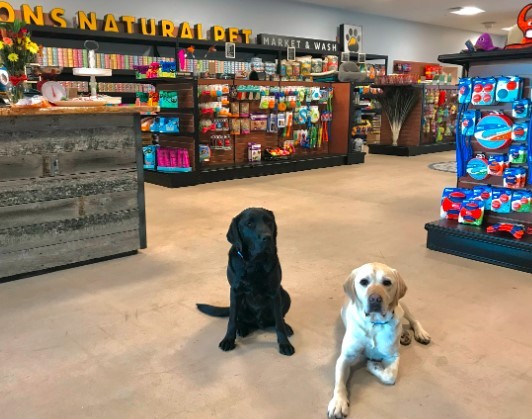
Introduction
The global Pet Care Market has witnessed significant growth in recent years, driven by factors such as increasing pet ownership, rising disposable incomes, and changing consumer preferences. In this blog, we provide an overview of the global pet care market, highlighting key trends, growth drivers, and major players in the industry.
Market Size and Growth
The global pet care market size was valued at USD 150.67 billion in 2021 and is projected to expand at a compound annual growth rate CAGR of 5.1% from 2022 to 2030. The market is expected to reach USD 230.45 billion by 2030, driven by the growing trend of pet humanization and increased consumer spending on pet-related products and services.
Pet Ownership Trends
Pet ownership has been on the rise globally, with approximately 85 million households owning a pet. The trend of pet humanization, where pets are treated as members of the family, has contributed to increased spending on pet care products and services. Millennials and Generation Z consumers, in particular, are driving the demand for pet-related products and are willing to invest in premium pet care solutions.
Impact of COVID-19
The COVID-19 pandemic has further accelerated the growth of the pet care market. With more people spending time at home, there has been an increase in pet adoptions and fostering. Additionally, pet owners are showing a strong desire to learn more about pet health issues, leading to increased spending on preventive care and wellness products.
Key Players in the Industry
Several companies dominate the global pet care market, offering a wide range of products and services to meet the needs of pet owners. Some of the key players in the industry include:
Nestle Purina PetCare
Mars, Incorporated
Hill's Pet Nutrition, Inc.
Blue Buffalo Co., Ltd.
Champion Petfoods LP
Ancol Pet Products Limited
Petmate Holdings Co
The Hartz Mountain Corporation
Spectrum Brands Holdings, Inc.
These companies compete by offering innovative products, expanding their distribution networks, and investing in marketing and advertising campaigns to attract pet owners.
Future Outlook
The future outlook for the global Pet Care Market remains positive, with continued growth expected in the coming years. Factors such as increasing pet ownership, rising consumer awareness about pet health and wellness, and technological advancements in pet care products are expected to drive market growth.
Conclusion
The global pet care market is a dynamic and rapidly growing industry, driven by changing consumer preferences and increasing pet ownership rates. With the right strategies and investments, companies can capitalize on the growing demand for pet care products and services and achieve long-term success in this thriving market.
#Pet Market Analysis#Pet Market Size#Cat Food Manufacturers#Online Dog Food Sales#Online Pet Food Companies#Top Pet Companies#Pet Industry#Pet Industry Research Reports#Pet Market Research Reports#Pet Market Demand#Pet Market Forecast#Pet Market Growth#Pet Market Outlook#Pet Market Revenue#Pet Market Trends#Pet Market Report#Pet Market Challenges#Pet Market Opportunities#Pet Food and Nutrition Industry Research Report#Pet Food and Nutrition Market Analysis#Pet Food and Nutrition Market Demand#Pet Food and Nutrition Market Forecast#Pet Food and Nutrition Market Growth#Pet Food and Nutrition Market Outlook#Pet Food and Nutrition Market Revenue#Pet Food and Nutrition Market Size#Pet Food and Nutrition Market Trends#Cat Food Market Reports#Dog Food Sales Online#Pet Food Market Size
1 note
·
View note
Text
Navigating the Pet Market Landscape: Market Share, Revenue and Growth
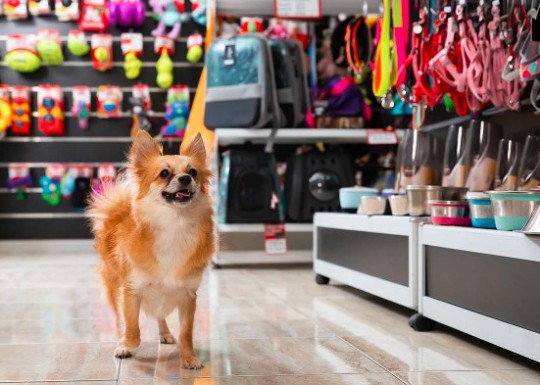
Introduction: The Flourishing Landscape of the Pet Market
In the realm where furry companions and commerce converge, the Pet Market stands as a testament to the inseparable bond between humans and their animal counterparts. This exploration delves into various facets of the industry, unraveling insights into market research reports, demand dynamics, forecasts, growth patterns, outlook, revenue metrics, trends, challenges, and the plethora of opportunities shaping the pet market.
Understanding Pet Market Demand: The Canine and Feline Frenzy
At the heart of the industry lies the dynamic force of Pet Market Demand. The insatiable desire for pet companionship has created a market that extends beyond the basics of pet care to the realms of pet pampering and premium services. Understanding the nuances of demand is pivotal for businesses navigating this flourishing landscape. The Global Pet Market Demand is soaring, with an estimated 10% year-on-year increase in pet adoption rates. Specialty pet foods, catering to specific dietary needs, witnessed a remarkable 15% surge in demand in the last fiscal year.
Forecasting the Future: Pet Market Forecast
Peering into the crystal ball, the Pet Market Forecast segment anticipates the trajectory of the industry. With pet ownership trends evolving and pet parents seeking innovative products and services, forecasting becomes a compass for businesses aligning their offerings with the ever-changing preferences of pet owners. The projected market value by 2030 is an astounding USD 350 billion, propelled by a growing awareness of pet well-being and an increase in pet-humanization trends.
Pet Market Growth
The heartbeat of the pet industry resonates in the rhythm of Pet Market Growth. With a projected annual growth rate of 5.8%, the industry is not just expanding; it's evolving. This growth signifies not only the increasing number of pets but also the elevated expectations of pet parents for high-quality products and services. The global pet market is poised to reach USD 269.9 billion by 2025, reflecting a CAGR of 5.8%. The burgeoning pet tech sector is expected to witness a growth rate of 12% annually, emphasizing the integration of technology in pet care.
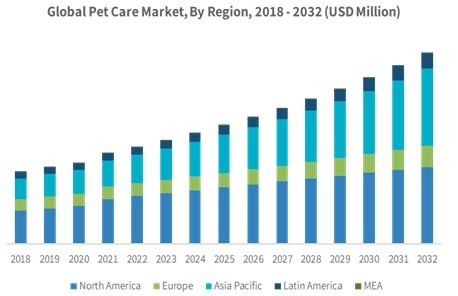
Outlook into Pet Paradise: Pet Market Outlook
The Pet Market Outlook envisions a world where pets are not just companions but integral members of households. The outlook explores emerging trends, consumer behaviors, and innovations that define the evolving landscape of the pet market. Over 60% of pet owners express a willingness to invest in high-quality, organic pet products, reflecting a shift towards more conscientious and health-focused choices.
Pet Market Revenue
Beyond cuddles and playtime, the pet industry is a formidable economic force, as evidenced by Pet Market Revenue. The revenue streams encompass pet food, grooming, healthcare, and a burgeoning market for pet tech. Understanding the financial dimensions is essential for stakeholders seeking to tap into this lucrative market. Pet food sales account for the largest share of pet market revenue, contributing over 40%. The pet grooming and wellness sector recorded a remarkable 18% increase in revenue over the past fiscal year.
Trends Tailoring the Pet Experience: Pet Market Trends
In the ever-evolving pet landscape, Pet Market Trends are akin to the wagging tail of innovation. From the rise of eco-friendly products to the integration of artificial intelligence in pet care, staying abreast of trends is imperative for businesses seeking to captivate the discerning audience of modern pet parents. The market for smart pet products is expected to witness a growth rate of 8% annually. Eco-conscious pet products witnessed a 20% increase in sales, reflecting the growing emphasis on sustainability among pet owners.
Deciphering Insights: Pet Market Report
The foundation of informed decision-making lies in the insights derived from Pet Market Reports. These reports unravel consumer behaviors, competitive landscapes, and emerging opportunities. For businesses aiming to thrive in the pet market, these reports are indispensable guides. Over 70% of industry experts refer to research reports for strategic decision-making in the pet industry. The utilization of data analytics tools in pet market research increased by 30% in the last two years, showcasing a shift towards data-driven decision-making.
Challenges in the Pet Playground: Pet Market Challenges
Amidst the tail wags and purrs, challenges abound in the Pet Market Challenges section. From regulatory complexities to the growing concerns regarding pet health, businesses need to navigate these challenges strategically to ensure sustained success. Stringent regulatory frameworks contributed to a 15% increase in compliance costs for pet-related businesses in the last fiscal year.
Opportunities in the Pet Kingdom: Pet Market Opportunities
Within challenges lie opportunities, and the Pet Market Opportunities segment illuminates the pathways for growth. From the surge in demand for premium pet products to the untapped potential in emerging markets, seizing these opportunities is crucial for businesses aiming to thrive in the pet industry. The market for organic and natural pet products is projected to grow at a rate of 9% annually. Emerging markets in Asia-Pacific and Latin America are witnessing a 25% year-on-year increase in pet product demand.
Conclusion: Pawing Towards a Prosperous Future
In the final analysis, the Pet Market is more than a marketplace; it's a reflection of the evolving dynamics between humans and their beloved pets. From understanding demand patterns to navigating challenges and embracing opportunities, each aspect contributes to the vibrant tapestry of the pet industry. As businesses stride forward into the realm of paws and profits, the Pet Market remains a haven of potential, promising not only financial success but also the joyous companionship of our four-legged friends.
#Pet Market Analysis#Pet Market Size#Cat food manufacturers#Online dog food sales#Online pet food companies#Top pet companies#Pet Industry#Pet Industry research reports#Pet market research reports#Pet Market Demand#Pet Market Forecast#Pet Market Growth#Pet Market Outlook#Pet Market Revenue#Pet Market Trends#Pet Market Report#Pet Market Challenges#Pet Market Opportunities#Pet food and nutrition Industry research report#Pet food and nutrition Market Analysis#Pet food and nutrition Market Demand#Pet food and nutrition Market Forecast#Pet food and nutrition Market Growth#Pet food and nutrition Market Outlook#Pet food and nutrition Market Revenue#Pet food and nutrition Market Size#Pet food and nutrition Market Trends
0 notes
Text

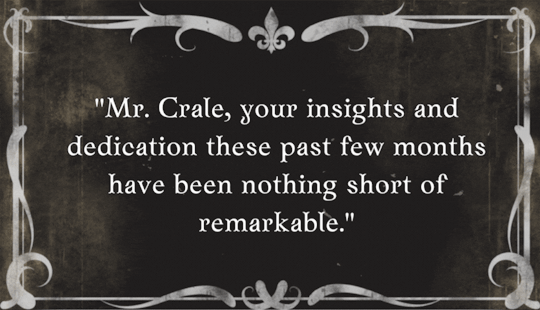



To: Mr. Carmichael, General Manager
From: Patrick Crale, Assistant to the Manager
Date: November 22, 1912
Subject: Quarterly Report on Import/Export Activities in Brindleton Bay
Introduction:
I am pleased to present the quarterly report on our import and export activities in Brindleton Bay. This report provides an overview of our operations, market trends, challenges, and opportunities observed during the past quarter.
I. Import Activities:
Goods Imported: Key imports included life fruit, alchemy elixirs, and exotic fish.
Major Trading Partners: Our primary import partners were Selvadorada, Sulani, and Henford-on-Bagley.
Challenges: Delays in shipping due to weather conditions and increased tariffs on magical goods.
Opportunities: Potential to expand into new markets, particularly in luxury furniture and rare collectibles.
II. Export Activities:
Goods Exported: Main exports consisted of Brindleton Bay's specialty products such as gourmet pet food, crafted sculptures, paintings, and local nectars.
Major Trading Partners: Primary export destinations were Willow Creek, San Myshuno, and Windenburg.
Challenges: Fluctuating currency exchange rates in Simoleons and competition from local producers in target markets.
Opportunities: Growing demand for Brindleton Bay's artisanal goods and unique cultural products.
III. Financial Overview:
Revenue: Total revenue for the quarter amounted to §1,250,000 Simoleons.
Expenses: Operating expenses, including shipping, tariffs, and labor, totaled §950,000 Simoleons.
Net Profit: The net profit for the quarter was §300,000 Simoleons.
IV. Recommendations:
Diversify Trading Partners: Explore new markets to reduce dependency on existing trading partners.
Invest in Technology: Modernize shipping and inventory management to improve efficiency.
Monitor Regulatory Changes: Stay abreast of international trade regulations and tariffs to mitigate potential risks.
Conclusion:
The past quarter has shown steady growth in both import and export activities in Brindleton Bay. By capitalizing on emerging opportunities and addressing current challenges, we can position ourselves for continued success in the coming months.
Please review the attached detailed financial statements and market analysis for further insights. I am available to discuss the report and our strategic direction at your earliest convenience.
Sincerely,
Patrick Crale
Assistant to the Manager
Brindleton Bay Trading Company
(Again, the lot was built by the @antiquatedplumbobs!)
#thats right i went to business school!!#and got a degree in IT. patrick would be disappointed in me if he knew what a computer was#i wrote out this whole thing so im going to post it even tho its not at all relevant#ts4#ts4 story#ts4 legacy#sims 4#sims 4 historical#crale legacy
12 notes
·
View notes
Text
U.S. Pet Daycare Market Outlook On The Basis Of Pet Type, Delivery Channel, Service Type And Forecast From 2022 to 2030: Grand View Research Inc.
U.S. Pet Daycare Market Outlook On The Basis Of Pet Type, Delivery Channel, Service Type And Forecast From 2022 to 2030: Grand View Research Inc.
San Francisco, 10 Nov 2022: The Report U.S. Pet Daycare Market Size, Share & Trends Analysis Report By Pet Type (Dogs (Large Breeds, Medium Breeds, Small Breeds), Cats), By Service Type (Day Boarding, Pet Sitting), By Delivery Channel, And Segment Forecasts, 2022 – 2030
The U.S. pet daycare market size is anticipated to reach USD 2.02 billion by 2030, according to a new report by Grand View…
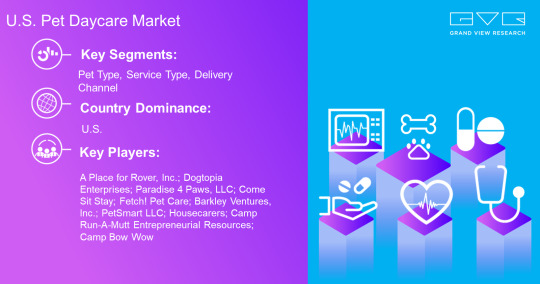
View On WordPress
0 notes
Text
Viva Piñata

After the monumental success of Pokemon in 1996, several other companies tried giving the monster-catching craze a shot in attempts to reach the same level of commercial bounty that Game Freak and Nintendo had, though it rarely led to any long-term success. This wasn’t exclusive to just the later 90s though, since Pokemon’s continuing status as a media empire meant that there must still be a market for quirky critter-catching simulators. Enter Microsoft, who joined the gaming industry in 2001, and had a stroke of good fortune with their second console, the Xbox 360. Competing with the Nintendo Wii and PlayStation 3, the Xbox 360 was pretty popular and widespread for the time, encouraging Microsoft to find more ways to branch out and expand their console’s appeal.
Microsoft was also in control of Rare Ltd. at the time, the creators of games like Donkey Kong Country and Banjo-Kazooie. Figuring they could make something with broad, marketable appeal similar to Pokemon, Microsoft gave them the task of creating a new monster-collecting IP. Luckily, Rare already had a concept lying around that could fit the bill, so they set out to work developing what was supposed to be a new juggernaut. They even paired with 4Kids to get a cartoon made and ready during the game’s development.

The end result was Viva Piñata, a cross between a gardening and a pet raising simulator that gives players a garden to call their own and decorate in attempts to attract wild living piñatas to hopefully tame and live there. True to Rare’s standard affair, the game is very colorful and nicely stylized, featuring several different piñatas who each (usually) have names that combine what type of animal they are with a sugary food. You can even get the piñatas to breed if you so choose, encouraged since only 2 of one piñata type will show up in the wild at a time.
The piñatas aren’t the only thing players have to care for, though, since gardening does matter quite a bit, and plants can be farmed and bred in order to create flora which better attracts the wild paper-mâché fauna. Things aren’t all bright and cheery though, since not only will players be tormented by villainous Ruffians who seek to ruin the garden and even smash piñatas, but players are also encouraged to do some pretty twisted things to their piñatas in order to make extra cash. I mean, these are living creatures you’re sending out to get smashed at parties, after all.

Unfortunately, though, Viva Piñata didn’t see anywhere near the amount of success Microsoft was really hoping for. Despite getting that cartoon made, and spending quite a bit on marketing (I remember there being a line of Kid’s Meal toys at one fast food chain), the game struggled to find a solid foothold in the market. It sold well enough, around 500,000 copies a year after its launch, but nowhere near Pokemon’s multimillion figures.
Truthfully, it didn’t mesh well with the Xbox’s primary demographic, which were teenagers and adults who bought the console for online shooters like Halo. The children who did buy it weren’t much better off, since, while bright and welcoming on the outside, Viva Piñata has some unnecessarily strict and complex mechanics and requirements for progression that children would likely be unable to micromanage and organize. Game progression can be pretty simple, but if you’re looking to tame all the piñatas or generate a steady stream of revenue, be ready to open the in-game encyclopedia multiple times. Several piñatas have wickedly complex requirements in order to be tamed or breed.
Viva Piñata would get a sequel two years later, a truncated DS ‘port,’ and a party game spinoff, but would seem to fade away from the public’s – and Microsoft’s – consciousness soon after. It’s a real shame, if you ask me, since it’s clear that like so many of Rare’s other games a real level of care and attention to detail has been put into these games that elevates them a bit higher than other ‘Pokemon Clones.’ Hell, with how different Viva Piñata’s gameplay is, I don’t think it may even be fair to call it a Pokemon Clone, it stands well enough on its own as a unique experience.
To give this forgotten game some fresh attention, I wanted to go ahead and share some of the piñatas which I enjoy the most or find to be quite noteworthy. There are about 60 different species in total, so I can’t cover every single one of them, but hopefully this selection should still do them some justice.
Mousemallow

“My crazy grandmother always said: 1. Mousemallows are never bigger than the gap under the pantry door, 2. never fall for the "blind" routine, and 3. never trust a Mousemallow wearing pants!”
Starting with a simple one, Mousemallow is Viva Piñata’s resident cute tiny rodent. The huge paper or cardboard discs are a clever way to give it big, comical ears, and the darker coloring around its eyes gives it a cute bandit mask look. Purple is a nice palette for it, but each piñata comes with 3 alternate palettes for you to customize them with as well, Mousemallow has one that’s solid yellow that occurs whenever it eats cheese.
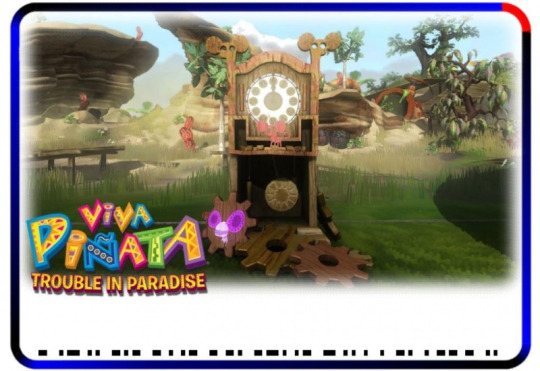
Each piñata species also comes with a unique home building you can place in your garden (which isn’t necessary to keep them around, but is if you want them to breed). Mousemallow’s is a large grandfather clock, which is quite clever given the Hickory Dickory Dock nursery rhyme. The additional mouse-shaped wood carvings are a nice touch too.
Buzzlegum

“Why do Buzzlegums make honey? I think it's a bribe so we'll be their friends. I mean, without the delicious, sweet honey, you're left with nothing more than a fat wasp.”
I don’t think you can get much dopier than this bee. This thing looks like it’s barely had a coherent thought in its life. Buzzlegums don’t have to just sit around and look stupid all day, though, you can build a bee box in your garden to make the Buzzlegum produce honey for some extra profit. If you make it wear its own beekeeper’s hat, it can even do the whole process automatically.
Candary

“Not only is the Candary small and yellow, but it can "detect" poison gas in mines. Not only pretty but practical too.”
The Candary’s description makes note of the poor bird’s tendency to be used to check for toxic fumes in mineshafts, something Rare already poked fun at in Banjo-Tooie with the character Canary Mary. Candaries don’t have it any easier, since you can build your own mineshaft in your garden for extra cash generation too. While you could hire some miners to dig out rocks for you, you could also buy a gas mask for your Candary and send it into the mines by itself instead. Remember when people half-jokingly (or even seriously) would question the ethics of Pokemon catching and battling? Well, the world of Viva Piñata has no qualms using these colorful candy-filled animals for hard manual labor. In fact, it’s even more efficient to have a Candary work in the mines since you don’t have to pay it salary. Now that’s economic!
Sherbat

“When Piñatas were just evolving, what would become the Sherbat was developing a taste for extreme sports. For a time, it looked like street-pizza extinction. Then one morning, that strange creature with the sagging armpits became a Sherbat legend!”
...what?
The Sherbat is kind of disappointing, since it looks more like a cartoon exaggeration of a rabbit more than it does a bat. It is pretty amusing, though, seeing it flap those tiny wings as it flutters around your garden.
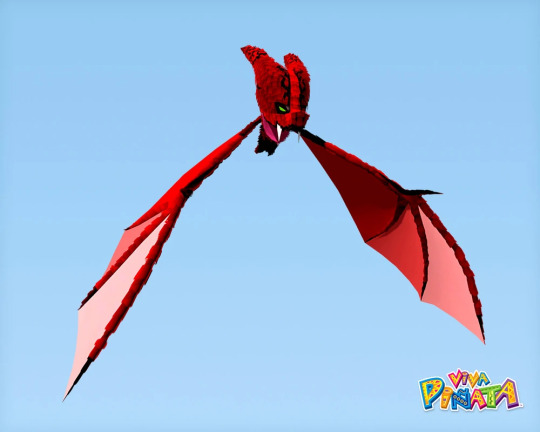
Actually, the Sherbat first comes in a Sour variant when spotted in the wild. Sour Piñatas are usually nuisances to your garden, causing a variety of problems either for your plants or current residents. The Sour Sherbat specifically will ‘drain’ your piñatas as if it were a vampire, causing them to fall ill. Once one Sour Piñata of a given species has been tamed though, all future wild piñatas of that species will be normal and harmless. It’s a shame though, in the case of the Sherbat, since the Sour variant is so much better looking than its normal design. I love the oversized wings and tiny body, and the sinister little eyes and fangs are a great touch too. You could theoretically keep a Sour Piñata in your garden if you wanted, but it would just cause annoyances until you either tame it or smash it into candy.

Sherbat homes are at least excellently designed. I really enjoy the exaggerated and uneven shapes of the gothic fence and tower, and the glowing green lantern is a great cherry on top.
Arocknid
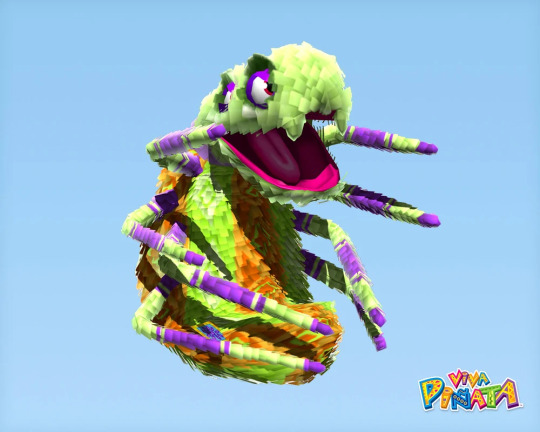
“This eight-legged Piñata is perfect for any birthday party that takes place on October 31st, but it's not always the most popular Piñata on the block. There's a reason some folks can't wait to whack it with a stick, and it's not just the candy inside!”
I’m happy to see a spider piñata is a part of this catalog, and even happier to see it has a full eight legs and multiple pairs of eyes. The description also shines some light on the fact that, despite being alive, these piñatas are still filled with candy and smashed at parties without remorse, which you can even send your own piñatas to for some cash. They always return unharmed, though, so you needn’t worry about their well-being. Physically, at least.
Arocknids are also predatory, they are based on spiders after all. Taming one means that you have to let it eat two of your Taffly or Raisant piñatas. It’s not hard to do that, since you can attract two piñatas of one type from the wild, but what the game doesn’t tell you is that you actually need 4 of either piñata in your garden to get the Arocknid to actually visit. As I said previously, you can’t attract that many of one species from the wild, so you’ve either got to buy more from a piñata hunter or start breeding them.

Also, one of Arocknid’s alternate palettes give it an orange body and purple legs, gained by eating – what else – a Jack-o-Lantern. Succeeding where Pokemon failed, I see.
Reddhott
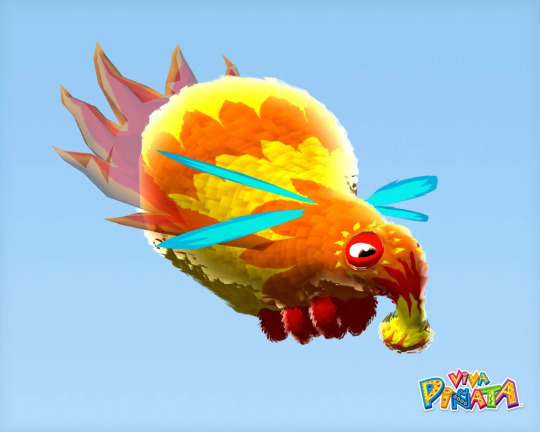
“Imagine scorching the furniture when you sit on it. Imagine having to move every few seconds because if you don't, the ground underneath you sets alight. What kind of life is that? Who is responsible for this?”
The Reddhott’s description shows how this game is still chock full of Rare’s signature sarcastic writing style, and acknowledges how twisted it is for you to go and make one these things. Unlike another piñatas, Reddhotts can’t be found in the wild, and instead must be evolved from pre-existing ones. By setting a normal Taffly piñata on fire, then quickly dousing it, you can get a Reddhott, the piñata version of a firefly. Kind of. It sells for quite a bit of money, and Tafflies are easy to come by, so you could get a bunch of them and turn them into Reddhotts for a quick profit. Y’know, if you were a demented pyromaniac or something.
Pudgeon

“All Pudgeons are filled with state-of-the-art GPS tracking systems. So, like a feathery boomerang, they always come back. Take them on holiday, load them up with duty-free and avoid hassle with the customs.”
This thing perfectly captures just about everything about Pigeons. The incredibly tiny eye is what seals the deal, though, I think. Just like the Buzzlegum, it looks appropriately dopey and thoughtless like the real thing.
Bizarrely, one of the requirements a Pudgeon needs to meet before it can breed is that it need’s to be wearing a Reporter’s Camera accessory. That’s a feature too, that you can dress up your piñatas in little knick-knacks and clothing accessories. Why a pigeon needs to wear a camera in order to procreate is beyond me, though.

The Pudgeon’s home is a statue of the game’s main antagonist, Professor Pester, only splattered with… some kind of white substance. You never see piñatas defecate during gameplay, so it’s a mystery where those droppings come from. Especially since you buy the statue already in that state.
Cluckles
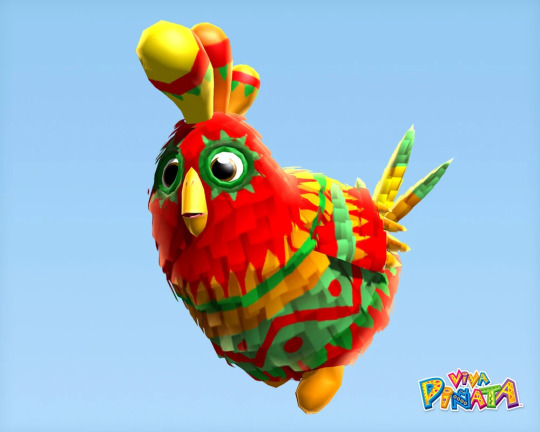
“Right from the beginning, scrambled, boiled, or fried; then there's the cute fluffy bit (ahhh); then we dive right back into roast, boiled or fried. How can there be any left?”
Cluckles is quite the cute chicken piñata, I really enjoy how round and simplified its body is, and the nice palette of red, orange, and green it’s got make a good mesh of colors. It looks like one of the most believable piñatas of the bunch, for what that’s worth. Cluckles is also quite a useful utility piñata too, since it’ll help speed up the hatching any eggs in your garden, helpful if you’re trying to get awards for breeding a piñata type multiple times.
Profitamole
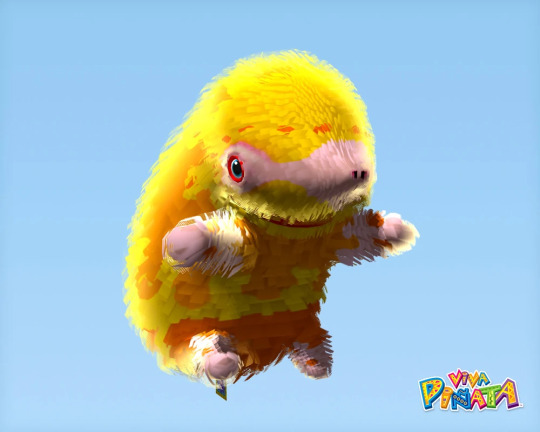
“All that time spent underground has deteriorated the Profitamole's eyes so they can barely see. This has probably saved the species because, let's face it, Profitamoles don't look too hot.”
I don’t know what that description is talking about, Profitamoles are positively ADORABLE. Look at how small and fluffy this thing is. It’s just a nugget of fuzzy piñata paper. I guess the problem might be the fact that it looks like it’s got red eyes? But that’s just rings around the outside of the eyes, otherwise it’s got a normal set of peepers. Profitamoles are helpful too, they’ll eat up and big clumps of dirt that happen to appear in your garden, either from improper mine usage or enemy Ruffians invading your turf.
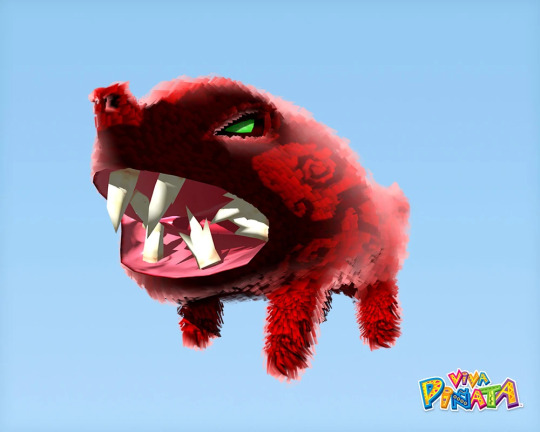
Profitamoles come in Sour variants too, and while they certainly aren’t cute anymore, they are quite cool with their huge mouths and gnarly, jagged teeth.
Newtgat

“Ever wanted a Jameleon but found out they were too expensive? Your old Lickatoad is looking tired and out-of-date? Get a Newtgat-functions like a Lickatoad but with all that expensive Jameleon styling that you love.”
Called a newt, but more clearly resembling an axolotl, Newtgats are incredibly cute amphibious piñatas. Yeah, amphibious, because despite being made of paper-mâché these things can swim around in water with no consequence whatsoever. Maybe due to the axolotl’s predatory nature, but if you have both a Newtgat and a frog-like Lickatoad in your garden, the two will constantly quarrel and start fights with the other. These ammphibians don’t get along, it seems.
The Newtgat is pretty simple in gameplay, but can be fed a chili pepper to evolve into a Salamango, quite clever since axolotls themselves are just larval salamanders which never fully mature.

The Salamango’s cool and all, and has a neat fire theme going on, but I’d keep a Newtgat just the way it was, though. Is this how people feel about Wooper in opposition to Quagsire? I guess it makes more sense now.
Twingersnap

“When it comes to improving something, it's obvious that two is twice as good as one. This is the next step in Syrupent evolution. But they aren't just two heads - the left head is touch sensitive too!”
An evolution of sorts from the basic snake piñatas, Twingersnaps are based on real world mutations found in snakes that create two heads between them, only Twingersnap is a snake with two heads at each end rather than a fork. The method of getting a Twingersnap is a bit morbid, since instead of evolving a current Syrupent into becoming one, you have to deliberately smash a Syrupent egg right before it would’ve hatched in order to get one. You’ve ruined his thing’s birth and given it an unnatural mutation. Things don’t just stop there, though, because there’s also…
Fourheads
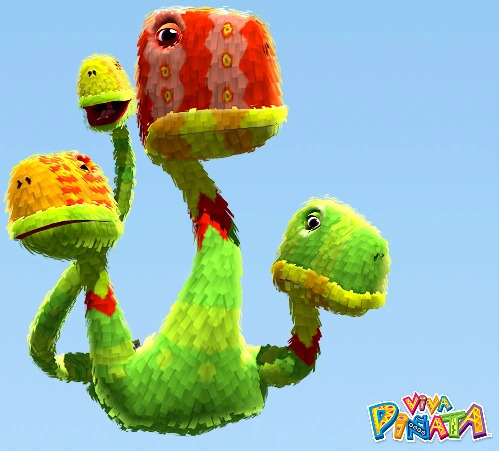
“Imagine the intellectual power! Four brains working in unison! A pity that someone skimped on the limbs, or this creature could have been revolutionary.”
Doing the same thing and smashing a Twingersnap egg will get you a Fourheads piñata, now resembling a hydra more than the average mutated snake. It even spits up argonaut helmets when attacking. Every piñata has a different object it uses when attacking, but none felt especially noteworthy until now. It’s a wonder that Fourheads is still able to breed and make eggs of its new species, considering it’s a mutation of a mutation. The wonders of piñata biology!
Doenut

“This animal is fast and flighty, not the sort of animal that you'd expect to get caught and eaten. Unfortunately, the horns on its head pick up T.V. signals and transmit them straight to its brain, a lethal distraction.”
A tamer example, the Doenut is a charmingly bright and colorful deer piñata. What’s most noteworthy about Doenut though, is what their house looks like.

For whatever reason, the Doenut’s home is a disco club, with a dancing deer neon sign. Sure, alright. Whatever makes these piñatas happiest I guess.
Macaraccoon
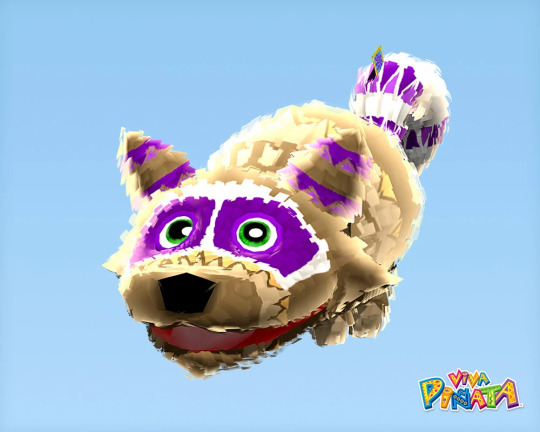
"The Macaraccoon is just naturally sneaky. You can trust it to behave now, but its twitchy movement doesn't inspire confidence."
Another big softie, the Macaraccoon gets the important charms of real raccoons down into a little candy-filled package. It even can upchuck Romance Candy once tamed - special food that helps piñatas breed faster if their specific requirements have already been met once before. The only downside about Macaracoons are that the game's aversion to use blacks or greys for piñatas' primary colors means that the Macaraccoon can't be a sleek monochrome, but it isn't a huge loss. The big mouth is pretty cute, it gives the Macaracoon a muppety look, almost.

Macaraccoons also come in Sour forms initially, featuring a huge rectangular shaped set of chompers they use to snack on any eggs you may have lying around. Dastardly for sure, but that red and black palette and set of oversized triangle teeth strike my fancy enough to maybe slip an egg or two its way. Hypothetically.

The Macaraccoon can be an utter pain to try and tame though, since it requires you to have 5 Master Romancer awards, only achieved once you’ve bred a piñata type at least 5 times (and keeping each child - it won’t count if you don’t have 7 members of a species in your garden at the same time).
Crowla

"When you see the Crowla, think less "dark, sinister, grave robber" and think more "garbage collector." It may stop that shiver tickling your spine."
Despite being a harmless, tamed piñata like all the others in your garden, Crowlas still has quite the mischevious grin of a ne'er-do-well that gives it a good splash of character that I like so much in my darkly-colored critter designs. Like Pokemon's own Murkrow, Crowlas has a jagged beak, nefarious-type expression, and charmingly gloomy palette. Crowlas also first appear in your garden as Sour Piñatas, but actually keep some traits from their eviller origins, namely the jagged underside of their beak. It might be my favorite of the whole bunch, honestly. Look at how devious it looks!

Sour Crowlas are much more wicked designs, thanks not only to the red and black palette, and the twisted curls of its patterns, but also the even more jagged shape of its beak, resembling a broken eggshell. I really like how most of the thing's body is dedicated to its mouth, it feels like some exaggerated enemy from another game. Sour Crowlas are quite dangerous since they'll kill sick piñatas before they can recover. Very morbid indeed!
Cocodile

"After some soothing, the Cocoadile's lethal snout becomes home to nature's widest grin."
Speaking of things that are almost entirely mouths, the Cocodile! This big gator's mouth is nearly twice the size of its own body, and its even got a bunch of rounded-down snaggletooths to boot just to make it even dopier and goofy looking. Cocodiles are actually pretty big in-game, but are entirely harmless like other tamed piñatas. In fact, Cocodiles have a utility feature, since they can be directed to water plants with their tears. Y'know, like crocodile tears, get it? I thought it was a bit clever.

There are Sour Cocodiles too, and I really like the contrast that they've got a big underbite in comparison to the normal Cocodile's overbite. That's a very imposing set of teeth, too. I've got to wonder what they're filling these piñatas with that isn't candy. Sour Cocodiles are quite a nuisance since they'll scare off any visiting NPCs in your garden, but who can blame them really?
Pigxie

"There is something very, very wrong here. I think this is a lesson in right and wrong for us all. That nagging voice in your head sometimes gets it right!"
The Pigxie isn't a natural piñata, and is instead a unique species created when you successfully get a pig-like Rashberry and a swan-like Swanana. Players hoping to receive a cool winged pig piñata will be sorely disappointed when this more realistically portrayed mutant hatches from the egg. The picture doesn't portray it well, but Pigxies are very asymmetrical and lopsided, leaning to one side at all times since their left seems to be lower down in their anatomy than the right. The left wing is smaller than the right, and its mouth even seems to be at a diagonal angle rather than the position it ought to be. Even worse, any tamed Rashberries or Swananas in your garden will try picking fights with Pigxies, as if deeply frightened and disgusted by the poor thing.
Surprisingly enough, like the Fourheads before it, Pigxies are actually capable of breeding still, but maybe it's better if you don't make that happen. One feature that I haven’t mentioned yet is that piñatas can come in ‘wild cards,’ meaning that a normal piñata will have some kind of additional feature on its body like spikes or tufts of fur. To get one means that you have to breed two piñatas while at least 6 members of that species are currently in your garden. I bring this up because these wild cards are effectively genetic mutations, unique traits and bodily growths which don’t carry down to future offspring. With enough dedication, you could. if you wanted, create a Pigxie with even more mutations. One of which includes a single, curled tusk, blocking most of its lopsided mouth.

Dragonache
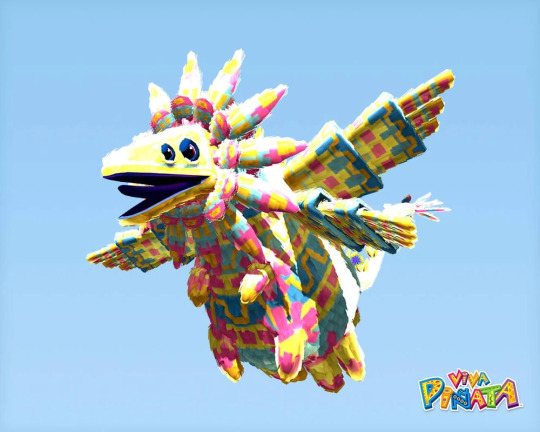
"The ground shakes as it moves, the trees quiver when it roars, its breath can scorch the earth. Truly incredible and utterly terrible, and all the more desirable for it."
The final species in the original game, the Dragonache is a hidden piñata that can't be found in the wild and instead must be discovered and raised through various complex means. If players have a mine in their garden and have used it often enough, a Dragonache egg may be unearthed in it. The egg must then be hatched by a Cluckles, and then the Dragonache baby must be fed a set of five items and other piñatas before fully maturing into an adult. None of this is explained clearly in-game, but unlike some of the other strict requiremetns for taming or breeding other piñatas I think this is alright since the Dragonache is meant to be a hidden reward to experienced players.
And it certianly is quite the reward! I really appreciate how the Dragonache isn't just a typical lizard-like dragon made into a piñata, but is isntead some weird conglomeration of a creature with 4 eyes, 4 wings, 8 legs, and a spiky mane of frills. What with the various intricate and colorful patterns all over its body too, the Dragonache certianly feels like an ultra-strong mythical beast of all piñatas. The presence of a Dragonache alone will also prevent Sour Piñatas from entering your garden again, regardless if you've tamed them or not, which is a nice touch as well.
That about does it for the piñatas I wanted to cover from the first game. If any of these interested you, or if you were disappointed that your preferred animal didn't have a piñata counterpart, don't fret, as this is only a decent selection of the full game's roster. I'd say try looking into the game's catalog if you're interested in more, but sadly Viva Piñata has much less documentation online than it ought to have. Though, that's not all! As I said earlier, Viva Piñata did end up getting a sequel a couple years after its release, which added even more piñata species, and new environments to boot. I'll cover my favorite additions from that game as well, so stick around if you want to see more paper-mâché foolishness.
24 notes
·
View notes